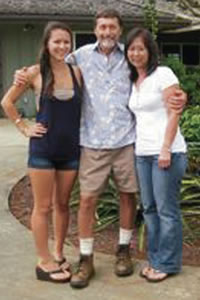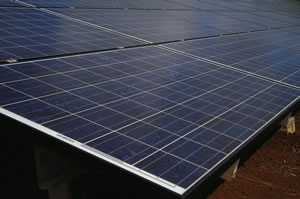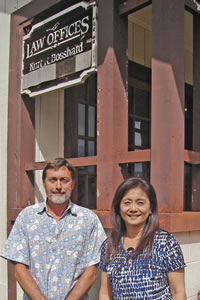harvesting the sun

Attorney Kurt Bosshard took a chance on a 5,000-panel solar farm in Kapaa, but was so confident he started building before receiving final approval. Today it provides electricity for 300 Eastside households, and is being touted as a model for the construction of future solar farms. Coco Zickos photo
Attorney Kurt Bosshard took a gamble on a solar farm, and it’s paying off for 300 Kaua’i households
Farming sunshine on Kaua’i has finally become a reality.
If it weren’t for Kapa’a Solar president Kurt Bosshard, the largest solar farm in the state might not be providing energy to some 300 households on the Eastside. And approximately 5,000 solar panels might not be pumping about 1 megawatt of power into the Kaua’i Island Utility Cooperative grid.
“It’s important for people to see the success we’ve had on this project so that they want to go forward with similar projects,” says Bosshard regarding the many different opportunities for alternative sources of energy in Hawaii.
And it took less than a year from the time Bosshard was initially approached to participate in the project, located on five acres of land adjacent to the Kapa’a bypass road, to the time he began harnessing the sun’s energy.

Bosshard enjoys the agrarian life
“I wanted to be able to see something done in short order rather than a process that would take years to do,” says Bosshard, who has been a family law attorney on Kaua’i for 30 years.
“If you have stability in the processing of the system, meaning the community is committed to it, the community’s leadership is committed to it – your state, county governmental entities – and the path is clearly defined, projects like this will go forward. I had a lot of help.”
And while most people would have waited for final approval from the Public Utilities Commission to start building, Bosshard surged forward, confident in the viability of his product.

Bosshard was so confident in the project, he started building before getting a permit. CocoZickos photos
“I felt that it was such a certainty that it would be approved that I took the risk,” he admits.
The project was structurally completed in December 2010, and PUC approval was obtained March 3, just nine months after landowner Greg Allen first contacted Bosshard about taking on the business venture.
“The land was fallow and not productively engaged. We were trying to make use of it rather than letting it go to an overgrown state,” says Bosshard, who lives in Wailua with wife Arlene and daughter Lindsey, 18, an Island School graduate.
The project has been so successful thus far that KIUC is looking to implement more renewable projects of its kind across Kaua’i, although getting projects of this nature off the ground has been challenging, according to KIUC engineer Steven Rymsha.

Bosshard was happy to flip the switch for the first time
“But this is the first of many more to come,” he says.
Mayor Bernard P. Carvalho Jr. agrees.
“This project is extremely important to show that large-scale solar can be done and that it can provide reliable power to the grid,” the mayor says. “The results so far are outstanding, and Kurt is to be commended for his leadership. Hopefully it will pave the way for other successful projects.”
Without the county administration’s support and commitment to getting the project going in an expedited fashion, it would not have happened.
“I wouldn’t have engaged in this if I hadn’t had confidence in the mayor and his ability to marshal resources to move this thing forward, because time is of the essence,” says Bosshard. “It can take awhile for these things, and you have to trust that the leaders who make the laws will leave them in place long enough to meet the expectations of the people who invest in these projects.”

The solar farm is located near the Kapaa bypass road. Photos courtesy Kurt Bosshard
One of his roles as president of Kapa’a Solar, aside from hiring some 40 residents to build the new landmark, is to apply for reimbursements from state and federal resources.
The $5.3 million project is expected to receive $2.6 to $2.7 million in return.
“That is what makes it economically viable,” Bosshard says. “because the rate that KIUC would pay for the power would not justify the purchase of the land and cost of construction.”
The island’s co-op will purchase power from Kapa’a Solar at a rate of 20 cents per kilowatt, which is “as cheap as you can get it” for 20 years, says Bosshard, a 1981 graduate of the University of Hawaii’s William S. Richardson School of Law.
Still, he understands there are critics of such subsidies.
“But it’s a question of whether the community wants projects like this, because you won’t do it without the assistance,” he says.

With daughter Lindsey and wife Arlene
It’s just not economically feasible. And while it’s unlikely that the project will bring down the cost of energy, it’s a substitute for energy that is coming from foreign, unreliable sources.
Yet Bosshard doesn’t tout sustainability and doesn’t lobby for any one particular energy source. Even though he says circumstances can change rather abruptly in terms of availability of other external sources of energy, and it’s probably a good idea to hedge our bets here on Kaua’i, he is not “a promoter of energy.”
“I think it’s just more of having it available so that people can understand the process,” says Bosshard, who wouldn’t even have dabbled in the industry had the opportunity not directly presented itself. “What I hope to offer is a look at one option. And being the first, it lends itself to such community discussion, and I’m open to sharing what I’ve learned with the public so that they can access the merit of the project.”
So until another economically viable opportunity in the renewable resources field presents itself, Bosshard will continue serving the community as a lawyer.

Bosshard’s 5,000 solar cells produce 1 megawatt of power. Coco Zickos photos
“It makes you feel a part of the community when you do the type of legal work that I do, because you interact with people at their most vulnerable moments and try to work through their problems with them to come out at a stronger place,” he says. “I made some of my best relationships with and through my clients, and I enjoy working with the other attorneys and the court to accomplish that end.”
He calls his office, from which he has been operating for nearly 30 years, “some-thing very far below a corporate entity.”
Arriving on Kaua’i for the first time at age 21, Bosshard, originally from Wisconsin, was attracted to the island’s beauty and its people. And if he’s not working in the office, he’s enjoying that beauty by tending to his livestock – cows, sheep and goats – and landscaping

With his assistant of 18 years, Tammy schoniwitz
“Anybody who’s from a rural environment likes to dabble in horticulture. It’s the way of life I grew up with,” he says.
But it’s for the community of Kaua’i that he really has a fondness, especially as it was the island’s residents who were responsible for supporting his business endeavor.
“The beauty of the community is people being all around you who are willing to help,” he says. “It isn’t about me and it’s not just my project. But it’s about my family, my neighbors, my friends, my business associates, people in the community who have been supportive. They made the project possible and share in the success. I couldn’t have even started the project without that support.”



